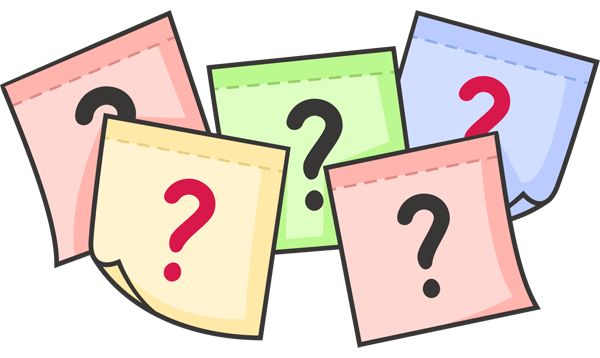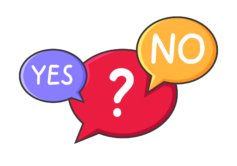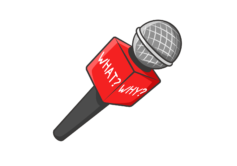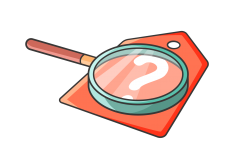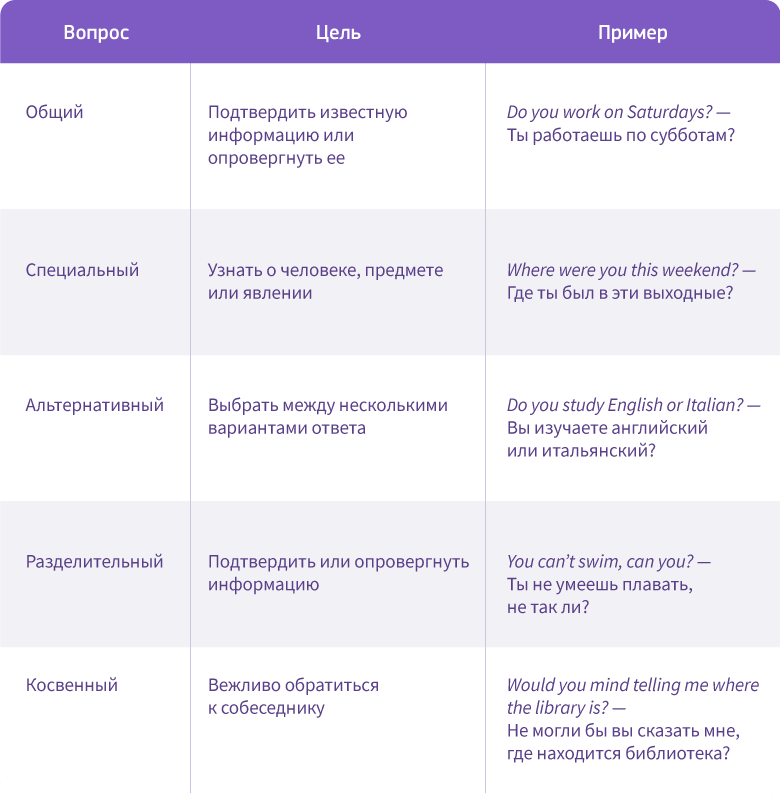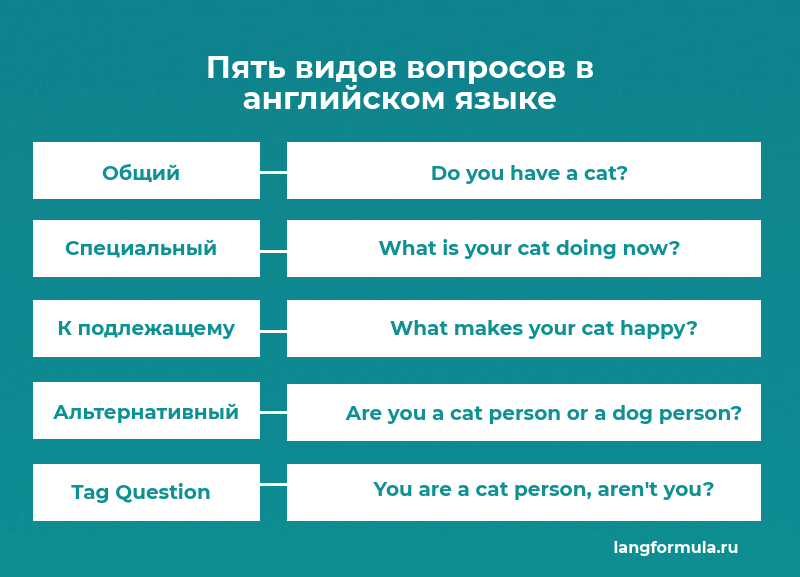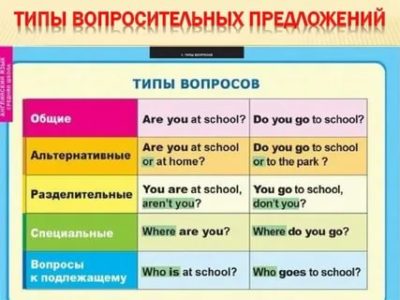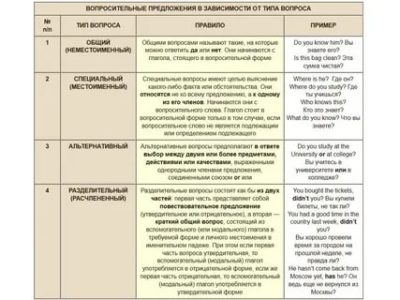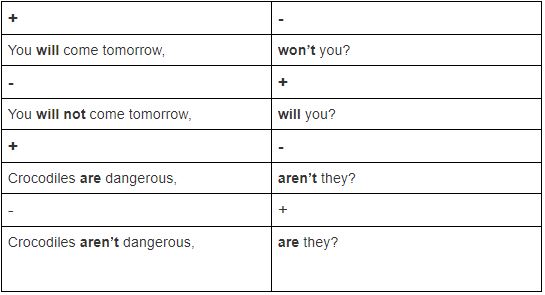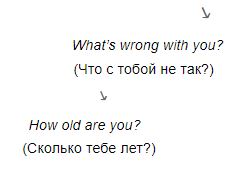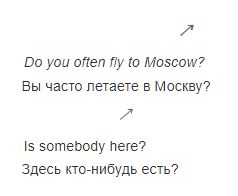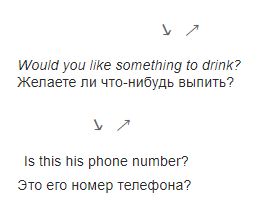General questions
In general questions, the auxiliary verb (do, be, have, will) is placed before the subject, and the main verb follows the subject, i.e., the word order is: auxiliary verb + subject + main verb (+ object + adverbial modifier). Responses to general questions can be in the form of short «Yes» or «No» answers or in the form of full statements. (General questions are also called Yes / No questions or yes-no questions.) General questions are pronounced with rising intonation.
Do you live here? – Yes, I do. / Yes, I live here. – No, I don’t. / No, I don’t live here.
Does Bell work? – Yes, she does. – No, she doesn’t.
Did you like the film? – Yes, I did. – No, I didn’t like the film.
Are you reading now? – Yes. / Yes, I am. / Yes, I’m reading now. – No. / No, I am not. / No, I’m not reading.
Have the guests left already? – Yes, they have. – No, they haven’t.
Will you see him tomorrow? – Yes, I will. / Yes, I will see him. – No, I won’t. / No, I will not.
General questions with modal verbs have the same structure and word order.
Can you help me? – Yes, I can. / Yes, I can help you. – No, I can’t. / No, I can’t help you.
Should we call Maria? – Yes. / Yes, we should. – No. / No, we shouldn’t.
May I come in? – Yes, you may. – No, you may not.
In general questions with the verb BE as a main verb or a linking verb, the verb BE is placed before the subject.
Is he in Rome now? – Yes. / Yes, he is in Rome now. – No. / No, he isn’t.
Is Anna a teacher? – Yes, she is. / Yes, Anna is a teacher. – No, she isn’t. / No, Anna is not a teacher.
Were they happy? – Yes, they were. – No, they weren’t.
Word order in negative questions
Didn’t she like the film? – Yes, she did. / Yes, she liked the film. – No, she did not. / No, she didn’t like it.
Aren’t they reading now? – Yes, they are. / Yes, they are reading now. – No, they aren’t. / No, they are not reading now.
Isn’t he a student?
Hasn’t he left already?
Won’t you see him tomorrow?
Can’t you speak more slowly?
Note: Negative questions usually contain some emotion, for example, expecting «yes» for an answer, surprise, annoyance, mockery. Negative questions may sound impolite in some situations, for example, in requests. Read more about negative questions in Word Order in Requests and Requests and Permission in the section Grammar.
Special questions
When the question is put to any part of the sentence, except the subject, the word order after the interrogative word (e.g., how, whom, what, when, where, why) is the same as in general questions: interrogative + auxiliary verb + subject + main verb (+ object + adverbial modifier). The answer is usually given in full, but short responses are also possible. Special questions (information questions) are pronounced with falling intonation.
How did you get there? – I got there by bus. / By bus.
How much did it cost? – It cost ten dollars. / Ten dollars.
How many people did he see? – He saw five people. / Five.
How long have you been here? – I’ve been here for a week. / For a week. / A week.
Who(m) will you ask? – I’ll ask Tom. / Tom.
What is he doing? – He’s sleeping. / Sleeping.
What did she say? – Nothing.
What book is he reading? – The Talisman.
Which coat did she choose? – The red one.
When is he leaving? – He’s leaving at six. / At six.
Where does she live? – She lives on Tenth Street. / On Tenth Street.
Where are you from? – I am from Russia. / From Russia.
Where did he go? – He went home. / Home.
Why are you late? – I missed my bus.
Why didn’t you call me? – I’m sorry. I forgot.
Questions to the subject
When the interrogative word «who» or «what» is the subject in the question (i.e., the question is put to the subject), the question is asked without an auxiliary verb, and the word order is that of a statement: interrogative word (i.e., the subject) + predicate (+ object + adverbial modifier). The same word order is used when the subject of the question is in the form of which / whose / how many + noun.
Who told you about it? – Tom told me. / Tom did. / Tom.
Who called her yesterday? – I called her. / I did.
Who will tell him about it? – I will.
Who hasn’t read this book yet? – I haven’t.
What happened? – I lost my bag.
What made you do it? – I don’t know.
Which coat is yours? – This coat is mine. / This one.
Whose book is this? – It’s mine.
How many people came to work? – Ten people came to work. / Ten.
Note: «who» and «whom»
Nominative case – who; objective case – whom. The interrogative word «whom» is often replaced by «who» in everyday speech and writing, but «who» is an object in this case, not the subject, i.e., it is not a question to the subject. Consequently, an auxiliary verb is required for the formation of special questions in which «who» is used instead of «whom», and the word order in them is that of a question, not of a statement. Compare:
Who saw you? – Tom saw me.
Who / whom did you see? – I saw Anna.
Who asked her to do it? – Ben asked her.
Who / whom did she ask for help? – She asked Mike to help her.
Prepositions at the end of questions
When the interrogatives «what, whom/who» ask a question to the object with a preposition, the preposition is often placed at the end of the question after the predicate (or after the direct object, if any), especially in everyday speech.
What are you talking about? – I’m talking about our plans.
What are you interested in? – I’m interested in psychology.
Who are you looking at? – I’m looking at Sandra.
Who does it depend on? – It depends on my brother.
Who are you playing tennis with on Friday? – I’m playing tennis with Maria.
Who did she make a pie for? – She made a pie for her co-workers.
Note that not all prepositions can be placed at the end of such special questions, and the preposition at the end should not be too far from the interrogative word. In formal speech and writing, placing the preposition before the interrogative word in long constructions is often considered more appropriate. For example: With whom are you playing tennis on Friday? For whom did she make a pie?
Alternative questions
Word order in alternative questions (questions with a choice) is the same as in general questions. The answer is usually given in full because you need to make a choice, but short responses are also possible. Use the rising tone on the first element of the choice (before «or») and the falling tone on the second element of the choice.
Is your house large or small? – My house is small. / It’s small.
Are you a first-year or a third-year student? – I’m a third-year student.
Would you like tea or coffee? – I’d like coffee, please.
Would you like to go to a restaurant or would you rather eat at home? – I’d rather eat at home.
Alternative questions are sometimes asked in the form of special questions:
Where does he live: in Paris or Rome? – He lives in Rome. / In Rome.
Which do you like more: hazelnuts or walnuts? – I like hazelnuts more than walnuts. / Hazelnuts.
Tag questions
A tag question (a disjunctive question) consists of two parts. The first part is a declarative sentence (a statement). The second part is a short general question (the tag). If the statement is affirmative, the tag is negative. If the statement is negative, the tag is affirmative. Use falling intonation in the first part and rising or falling intonation in the second part of the tag question.
With the verb BE:
It’s a nice day, isn’t it?
He is here now, isn’t he?
It was true, wasn’t it?
He wasn’t invited, was he?
With main verbs:
You know him, don’t you?
He went there, didn’t he?
She will agree, won’t she?
He hasn’t seen her, has he?
He’s sleeping, isn’t he?
He didn’t study French, did he?
With modal verbs:
You can swim, can’t you?
He should go, shouldn’t he?
I shouldn’t do it, should I?
Responses to tag questions
Responses to tag questions can be in the form of short «Yes» or «No» answers or in the form of full statements. Despite the fact that tag questions are asked to get confirmation, the answer may be negative.
You live here, don’t you?
Yes, I do. / Yes, I live here. (agreement)
No, I don’t. / No, I don’t live here. (disagreement)
You don’t live here, do you?
No, I don’t. / No, I don’t live here. (agreement)
Yes, I do. / Yes, I live here. (disagreement)
It was difficult, wasn’t it?
Yes, it was. / Yes, it was difficult. (agreement)
No, it wasn’t. / No, it wasn’t difficult. (disagreement)
It wasn’t difficult, was it?
No, it wasn’t. / No, it wasn’t difficult. (agreement)
Yes, it was. / Yes, it was difficult. (disagreement)
(Intonation in different types of questions is described in Falling Intonation and Rising Intonation in the section Phonetics.)
Порядок слов в вопросах
Общие вопросы
В общих вопросах, вспомогательный глагол (do, be, have, will) ставится перед подлежащим, а основной глагол следует за подлежащим, т.е. порядок слов такой: вспомогательный глагол + подлежащее + основной глагол (+ дополнение + обстоятельство). Ответы на общие вопросы могут быть в виде кратких ответов Yes или No или в виде полных повествовательных предложений. (Общие вопросы также называются Yes / No questions или yes-no questions.) Общие вопросы произносятся с интонацией повышения.
Вы живете здесь? – Да, живу. / Да, я живу здесь. – Нет, не живу. / Нет, я не живу здесь.
Белл работает? – Да, она работает. – Нет, она не работает.
Вам понравился фильм? – Да, понравился. – Нет, мне не понравился фильм.
Вы читаете сейчас? – Да. / Да, читаю. / Да, я читаю сейчас. – Нет. / Нет, не читаю. / Нет, я не читаю.
Гости уже ушли? – Да, они ушли. – Нет, они не ушли.
Вы увидите его завтра? – Да, увижу. / Да, я увижу его. – Нет, не увижу.
Общие вопросы с модальными глаголами имеют такое же строение и порядок слов.
Вы можете мне помочь? – Да, могу. / Да, я могу помочь вам. – Нет, не могу. / Нет, я не могу помочь вам.
Следует ли нам позвонить Марии? – Да. / Да, следует. – Нет. / Нет, не следует.
Можно мне войти? – Да, можно. – Нет, нельзя.
В общих вопросах с глаголом BE как основным глаголом или глаголом-связкой, глагол BE ставится перед подлежащим.
Он сейчас в Риме? – Да. / Да, он сейчас в Риме. – Нет.
Анна учитель? – Да. / Да, Анна учитель. – Нет. / Нет, Анна не учитель.
Они были счастливы? – Да, были. – Нет, не были.
Порядок слов в отрицательных вопросах
Разве ей не понравился фильм? – Да, понравился. / Да, ей понравился фильм. – Нет, не понравился. / Нет, ей он не понравился.
Разве они не читают сейчас? – Да, читают. / Да, они читают сейчас. – Нет, не читают. / Нет, они не читают сейчас.
Разве он не студент?
Разве он уже не ушел?
Разве вы не увидите его завтра?
Разве вы не можете говорить помедленнее?
Примечание: Отрицательные вопросы обычно содержат какую-то эмоцию, например, ожидание ответа yes, удивление, раздражение, насмешку. Отрицательные вопросы могут звучать невежливо в некоторых ситуациях, например, в просьбах. Прочитайте еще об отрицательных вопросах в статьях Word Order in Requests и Requests and Permission в разделе Grammar.
Специальные вопросы
Когда вопрос ставится к любому члену предложения, кроме подлежащего, порядок слов после вопросительного слова (например, как, кого, что, когда, где, почему) такой же, как в общих вопросах: вопросительное слово + вспомогательный глагол + подлежащее + основной глагол (+ дополнение + обстоятельство). Ответ обычно дается полностью, но краткие ответы тоже возможны. Специальные вопросы (информационные вопросы) произносятся с интонацией понижения.
Как вы туда добрались? – Я добрался туда автобусом. / Автобусом.
Сколько это стоило? – Это стоило десять долларов. / Десять долларов.
Сколько человек он увидел? – Он увидел пять человек. / Пять.
Сколько вы здесь пробыли? – Я пробыл здесь неделю. / Неделю. / Неделю.
Кого вы спросите? – Я спрошу Тома. / Тома.
Что он делает? – Он спит. / Спит.
Что она сказала? – Ничего.
Какую книгу он читает? – «Талисман».
Которое пальто она выбрала? – Красное.
Когда он уезжает? – Он уезжает в шесть. / В шесть.
Где она живет? – Она живет на Десятой улице. / На Десятой улице.
Откуда вы? – Я из России. / Из России.
Куда он пошел? – Он пошел домой. / Домой.
Почему вы опоздали? – Я пропустил свой автобус.
Почему вы мне не позвонили? – Извините. Я забыл.
Вопросы к подлежащему
Когда вопросительное слово who или what является подлежащим в вопросе (т.е. вопрос ставится к подлежащему), вопрос задается без вспомогательного глагола и порядок слов как в повествовательном предложении: вопросительное слово (т.е. подлежащее) + сказуемое (+ дополнение + обстоятельство). Такой же порядок слов, когда подлежащее в вопросе в виде which / whose / how many + существительное.
Кто вам сказал об этом? – Том сказал мне. / Том.
Кто ей звонил вчера? – Я звонил ей. / Я звонил.
Кто ему скажет об этом? – Я скажу.
Кто еще не прочитал эту книгу? – Я не прочитал.
Что случилось? – Я потерял свою сумку.
Что заставило вас сделать это? – Не знаю.
Которое пальто ваше? – Это пальто мое. / Вот это.
Чья это книга? – Моя.
Сколько человек пришли на работу? – Десять человек пришли на работу. / Десять.
Примечание: who и whom
Именительный падеж – who; косвенный падеж – whom. Вопросительное слово whom часто заменяется словом who в разговорной устной и письменной речи, но who в этом случае дополнение, а не подлежащее, т.е. это не вопрос к подлежащему. Следовательно, требуется вспомогательный глагол для образования специальных вопросов, в которых вопросительное слово who употреблено вместо whom, и порядок слов в них как в вопросе, а не как в повествовательном предложении. Сравните:
Кто видел вас? – Том видел меня.
Кого вы видели? – Я видел Анну.
Кто попросил ее сделать это? – Бен попросил ее.
Кого она попросила о помощи? – Она попросила Майка помочь ей.
Предлоги в конце вопросов
Когда вопросительные слова what, whom/who задают вопрос к дополнению с предлогом, предлог часто ставится в конец вопроса после сказуемого (или после прямого дополнения, если оно есть), особенно в разговорной речи.
О чем вы говорите? – Я говорю о наших планах.
Чем вы интересуетесь? – Я интересуюсь психологией.
На кого вы смотрите? – Я смотрю на Сандру.
От кого это зависит? – Это зависит от моего брата.
С кем вы играете в теннис в пятницу? – Я играю в теннис с Марией.
Для кого она сделала пирог? – Она сделала пирог для своих сотрудников.
Отметьте, что не все предлоги можно поместить в конец таких специальных вопросов, и предлог в конце предложения не должен быть слишком далеко от вопросительного слова. В официальной устной и письменной речи, помещение предлога перед вопросительным словом в длинных конструкциях часто считается более подходящим. Например: With whom are you playing tennis on Friday? For whom did she make a pie?
Альтернативные вопросы
Порядок слов в альтернативных вопросах (вопросах с выбором) такой же, как в общих вопросах. Ответ обычно дается полностью, потому что нужно сделать выбор, но краткие ответы тоже возможны. Употребите тон повышения на первом элементе выбора (перед or) и тон понижения на втором элементе выбора.
Ваш дом большой или маленький? – Мой дом маленький. / Маленький.
Вы студент первого или третьего курса? – Я студент третьего курса.
Вы хотели бы чай или кофе? – Я хотел бы кофе, пожалуйста.
Вы хотели бы пойти в ресторан или предпочли бы поесть дома? – Я предпочел бы поесть дома.
Альтернативные вопросы иногда задаются в форме специальных вопросов:
Где он живет: в Париже или Риме? – Он живет в Риме. / В Риме.
Что вы больше любите: фундук или грецкие орехи? – Я люблю фундук больше, чем грецкие орехи. / Фундук.
Разъединенные вопросы
Разъединенный вопрос (разделительный вопрос, расчлененный вопрос) состоит из двух частей. Первая часть – повествовательное предложение (утверждение). Вторая часть – краткий общий вопрос. Если повествовательное предложение утвердительное, краткий вопрос отрицательный. Если предложение отрицательное, краткий вопрос утвердительный. Употребите интонацию понижения в первой части и интонацию повышения или понижения во второй части разъединенного вопроса.
С глаголом BE:
Приятный день, не так ли?
Он здесь сейчас, не так ли?
Это была правда, не так ли?
Его не пригласили, не так ли?
С основными глаголами:
Вы знаете его, не так ли?
Он пошел туда, не так ли?
Она согласится, не так ли?
Он не видел ее, не так ли?
Он спит, не так ли?
Он не изучал французский язык, не так ли?
С модальными глаголами:
Вы можете плавать, не так ли?
Ему следует идти, не так ли?
Мне не следует этого делать, не так ли?
Ответы на разделительные вопросы
Ответы на разделительные вопросы могут быть в виде кратких ответов Yes или No или в виде полных повествовательных предложений. Несмотря на то, что разъединенные вопросы задаются для получения подтверждения, ответ может быть отрицательным.
Вы живете здесь, не так ли?
Да, живу. / Да, я живу здесь. (согласие)
Нет, не живу. / Нет, я не живу здесь. (несогласие)
Вы не живете здесь, не так ли?
Нет, не живу. / Нет, я не живу здесь. (согласие)
Нет, живу. / Нет, я живу здесь. (несогласие)
Это было трудно, не так ли?
Да, трудно. / Да, это было трудно. (согласие)
Нет, не трудно. / Нет, это было не трудно. (несогласие)
Это было не трудно, не так ли?
Нет, не трудно. / Нет, это было не трудно. (согласие)
Нет, трудно. / Нет, это было трудно. (несогласие)
(Интонация в различных типах вопросов описывается в статьях Falling Intonation и Rising Intonation в разделе Phonetics.)
Все предложения в английском языке выражают утверждение, отрицание или вопрос. Сегодня мы сфокусируем внимание на вопросительных предложениях, ведь именно с ними часто у студентов бывают трудности.
В английском всего 5 типов вопросов. Сегодняшняя статья – обзорная, это значит, что мы кратко расскажем о каждом из пяти типов вопросов, дадим таблицу для скачивания, ссылки на подробные статьи о каждом вопросе и, конечно, тест.
Давайте вспомним, что в английском есть определенный порядок слов в предложении: сначала идет подлежащее, за ним сказуемое, потом дополнение и остальные члены предложения. Но такой порядок слов нарушается в вопросе. Вопрос может начинаться с вопросительного слова или вспомогательного глагола (кроме разделительных вопросов), потом идет подлежащее, сказуемое, дополнение и остальные члены предложения. Всего в английском языке пять типов вопросов:
| Тип вопроса | Пример |
|---|---|
| Общий | Are you a booklover? – Ты любитель книг? Do you read books? – Ты читаешь книги? |
| Специальный | Why are you a booklover? – Почему ты любитель книг? When do you usually read books? – Когда ты обычно читаешь книги? |
| Альтернативный | Are you a booklover or a nonreader? – Ты любитель книг или нет? Do you read books or magazines? – Ты читаешь книги или журналы? |
| Разделительный | You are a booklover, aren’t you? – Ты любитель книг, не так ли? You don’t read books, do you? – Ты не читаешь книги, не так ли? |
| Вопрос к подлежащему | Who is a booklover? – Кто любитель книг? Who reads books? – Кто читает книги? |
Общий вопрос
Если на вопрос надо ответить «да» или «нет», то это общий вопрос. Его еще называют “Yes/No question”. Общая схема для такого вопроса выглядит так:
вспомогательный или модальный глагол + подлежащее + сказуемое + дополнение + остальные члены предложения.
Do (вспомогательный глагол) you (подлежащее) play (сказуемое) computer games (дополнение)? – Ты играешь в компьютерные игры?
Can (модальный глагол) you (подлежащее) do (сказуемое) it (дополнение) for me (остальные члены предложения)? – Ты можешь для меня это сделать?
Только не забывайте, что глаголу to be в настоящем и простом прошедшем времени не нужны никакие вспомогательные глаголы:
Are (глагол to be) you (подлежащее) at home (остальные члены предложения)? – Ты дома?
Was (глагол to be) he (подлежащее) at the cinema yesterday (остальные члены предложения)? – Он был вчера в кинотеатре?
- Подробно об общем вопросе читайте в статье «Общие вопросы в английском языке».
А еще вопросы во времени Present Simple разобрал преподаватель Alex:
Специальный вопрос
На такой вопрос уже просто «да» или «нет» не ответить. Он требует подробного и развернутого ответа. Специальный вопрос в английском языке отличается тем, что он может быть задан к любому члену предложения. Порядок слов в таких вопросах такой же, как и в общем, только в начале надо поставить одно из вопросительных слов:
- What? – Что?
- When? – Когда?
- Where? – Где?
- Why? – Почему?
- Which? – Который?
Обратите внимание, все вопросительные слова начинаются с wh, поэтому такой тип вопросов еще называется “Wh-questions”.
А вот так выглядит формула, по которой строят специальный вопрос:
вопросительное слово + вспомогательный или модальный глагол + подлежащее + сказуемое + дополнение + остальные члены предложения.
Where (вопросительное слово) are (вспомогательный глагол) you (подлежащее) going (сказуемое)? – Куда ты идешь?
What (вопросительное слово) do (вспомогательный глагол) you (подлежащее) want to read (сказуемое)? – Что ты хочешь почитать?
When (вопросительное слово) did (вспомогательный глагол) you (подлежащее) leave (сказуемое) the house (дополнение)? – Когда ты ушел из дома?
- Если вы хорошо изучили общий вопрос, то можете приступать к специальному. Мы уверены, что после прочтения нашей статьи «Специальный вопрос в английском языке», у вас не возникнет трудностей с этим типом.
Альтернативный вопрос
Посмотрите на название этого типа вопросов – «альтернативный», значит, что в вопросе должен быть выбор между двумя вариантами. Такой вопрос можно задать к любому члену предложения. И самое главное – здесь всегда вы встретите союз or (или). Формула такая же, как в общем вопросе, но надо не забыть поставить or там, где нужно. Рассмотрим, как мы можем задать альтернативные вопросы к такому предложению:
They finished writing the article at 5 p.m. – Они закончили писать статью в 5 вечера.
Did they finish writing the article in the morning or at night? – Они закончили писать статью утром или вечером?
Did they finish writing or reading the article? – Они закончили писать или читать статью?
- Если вам нужно больше материала по этому вопросу, то воспользуйтесь материалами статьи «Альтернативный вопрос в английском языке».
Разделительный вопрос
Порядок слов в таком вопросе прямой, как в обычном предложении. И только в конце такого предложения мы встретим вопрос, который называется tag. В русском языке тоже есть такой вопрос, и звучит он так: «не так ли?» / «не правда ли?» / «да?». Для того чтобы образовать tag-question, вспомогательный глагол и подлежащее надо поставить в конец предложения. Есть два способа образования такого вопроса в английском языке:
- Начало предложения утвердительное + краткий отрицательный вопрос.
- Начало предложения отрицательное + краткий положительный вопрос.
He reads a book, doesn’t he? – Он читает книгу, не так ли?
His friend is German, isn’t he? – Его друг немец, не так ли?
She doesn’t go to the church, does she? – Она не ходит в церковь, не так ли?
He is not at the meeting, is he? – Он не на встрече, не так ли?
Как видите, в большинстве случаев автор вопроса знает ответ на него, просто он хочет переспросить собеседника, показать удивление или недоверие.
- Не забудьте прочитать статью «Разделительные вопросы в английском языке». В ней вы найдете интересные случаи использования tag-question и много других примеров.
И, как всегда, преподаватель Alex в своем видео расскажет вам эту тему с точки зрения носителя английского. Тема разделительных вопросов та же, но немного под другим углом.
Вопрос к подлежащему
Самый легкий для формирования вопрос. Вам нужно взять утвердительное предложение, убрать подлежащее и вместо него поставить who (кто) или what (что). Никакие вспомогательные глаголы не нужны. Есть лишь один нюанс – в настоящем времени прибавляем окончание —s к глаголу.
Who invites guests for the party? – Кто приглашает гостей на вечеринку?
What makes you feel upset? – Что заставляет тебя грустить?
What happened to us? – Что случилось с нами?
- Даже несмотря на то, что тема кажется простой, мы все равно советуем вам заглянуть в статью «Вопрос к подлежащему в английском языке» за более подробной информацией.
Вот и все 5 типов вопросов в английском языке. Изучив способы их построения и скачав нашу табличку, вы без труда сможете определить, какой перед вами вопрос.
↓ Скачать таблицу «Типы вопросов в английском» (*.pdf, 49 Кб)
Хотите на практике отработать типы вопросов? Тогда пройдите наш тест:
Тест
Типы вопросов в английском языке 1
Если вы нашли ошибку, пожалуйста, выделите фрагмент текста и нажмите Ctrl+Enter.
Опубликовано: 3 недели назад
Собрали подборку статей о том, как грамотно задавать вопросы на английском.
Мы задаем вопросы, чтобы узнать информацию или выразить свою заинтересованность. Научиться составлять вопросительные предложения на английском непросто, поэтому этой теме мы посвятили несколько подробных статей.
В английском языке существует пять основных типов вопросов: общие, специальные, альтернативные, разделительные и косвенные.
Общий вопрос
Общие вопросы помогают подтвердить известную вам информацию или опровергнуть ее. Как правило, на такого типа вопросы отвечают кратко — yes или no.
Is she married? — Она замужем?
Did John visit his grandparents? — Джон навещал своих бабушку и дедушку?
Специальный вопрос
Специальный вопрос предполагает развернутый ответ собеседника. Чтобы грамотно его построить, нужно использовать вопросительные слова в начале предложения.
Where were you yesterday? — Где вы были вчера?
When can we go to the teacher? — Когда мы можем подойти к учителю?
Альтернативный вопрос
Задавая альтернативный вопрос, вы предлагаете собеседнику выбор между несколькими вариантами ответа.
How many tennis racquets does the sportsman need, one or more? — Сколько теннисных ракеток нужно спортсмену — одна или больше?
How will he travel: by car or by train? — Как он будет путешествовать: на машине или на поезде?
Разделительный вопрос
Разделительный вопрос оканчивается на короткую фразу, которая подталкивает собеседника подтвердить или опровергнуть информацию. Аналоги такой фразы в русском — «не так ли», «ведь так», «не правда ли».
Emmy is an actress, isn’t she? — Эмми — актриса, не так ли?
You remember Andrew, don’t you? — Ты же помнишь Эндрю, не правда ли?
Косвенный вопрос
Главная разница между косвенными и прямыми вопросами в том, что первые подчеркивают ваше вежливое обращение к собеседнику. Такой эффект достигается благодаря вводным фразам и непривычному для вопросов порядку слов в предложении.
Could you tell me whether he still works at school? — Ты бы мог подсказать, он до сих пор работает в школе?
Do you know when he arrives at his place? — Ты знаешь, когда он возвращается домой?
Итак, общий вопрос помогает подтвердить или опровергнуть известную вам информацию; специальный — получить развернутый ответ; альтернативный предлагает собеседнику выбор между вариантами; разделительный уточняет известную вам информацию; косвенный — подчеркнуто деликатный способ задать вопрос. Чтобы лучше запомнить, изучите таблицу с примерами.
© 2023 englex.ru, копирование материалов возможно только при указании прямой активной ссылки на первоисточник.
We cannot do without questions. We ask questions every day. We answer questions every day. Asking questions and getting answers to them, we become smarter. By asking questions we learn.
How to ask questions correctly? What are the types of questions in English?
Don’t worry if you don’t know yet. This is an easy and very interesting topic.
General questions (Yes/No Questions)
In some languages, we can only ask questions using interrogative intonation. In English, in order to form a question, we need additional tools:
- Auxiliary verbs.
- Special word order.
These tools depend on the type of questions we ask.
A general question (Yes/No Question) is one of the most popular and frequently used ways to get information.
A general question is a question that we can answer simply YES or NO.

We ask a general question when we don’t need more information. We ask a general question when it is enough for us to get YES or NO.
In English grammar, we call these questions: Yes / No questions or General Questions.
Look at the examples:
Question: Are you going to work today?
Answer: Yes, I am.Question: Do you want us to have dinner at a restaurant?
Answer: No, I don’t want to, thanks.
The word order inversion plays an important role in such questions.
It means that we put the auxiliary verb at the beginning. Not the subject. We put the subject after the auxiliary verb. Then we put the main verb. Then we can add the rest of the sentence.
Do you like your new job?
Does she know the secret?

We can also use modal verbs in general questions. In this case, we don’t need any auxiliary verbs. Because modal verb can play the auxiliary role for itself.
In such questions, we put the modal verb at the beginning of the sentence. After the modal verb, we put the subject. Then we put the main verb. Then we can add the rest of the sentence.
Could you do me a favor?
Can we help you this time?
Should I pretend to believe all that nonsense?
To form a general question with the verb to be, we also do not use auxiliary verbs. The verb to be, like modal verbs, forms questions on its own.
Is he saying something behind my back?
Are we really doing this again?
Look at the detailed explanation of what a general question consists of, this will help you better understand how we form them:
Do you know the answer?
Do (auxiliary) you (subject) know (predicate) the answer (object)? (question mark)
Can you help me?
Can (modal verb) you (subject) help (predicate) me (object)? (question mark)
Are you a writer?
Are (verb to be) you (subject) a writer (rest of the sentence) ? (question mark)
A special question differs from a general one in only one detail. A special question starts with a question word or question phrase.

We use a Special question to get additional information other than a YES / NO answer.
That is why a special question has a question word or phrase at the beginning.
Compare:
General yes / no question:
Will you go to work?
Special question with a question word:
When will you go to work?
We cannot simply answer yes/no to a Special question. Because a special question has an extra word or phrase at the beginning. This word or phrase influences the answer.
Question: Where were you yesterday?
Answer: I visited my friend Frank.
The word “where” in the question influenced the answer.
To ask a special question we usually use these question words:
- What?
- When?
- Where?
- Why?
- Which?
- Whose?
- Whom?
These question words begin with “Wh” so we often call special questions Wh-questions.
As you may have noticed, we use the same word order in Wh-questions as in General questions. We just simply add a question word (or question phrase) to the beginning of the question.
Question word + auxiliary / modal / to be verb + subject + predicate / object + rest of the sentence.
Take a look at examples:
When do you want me to leave?
Why do you stay with him?
What are you still doing here?
Why can’t you be with us tonight?
How long does he have to be in quarantine?
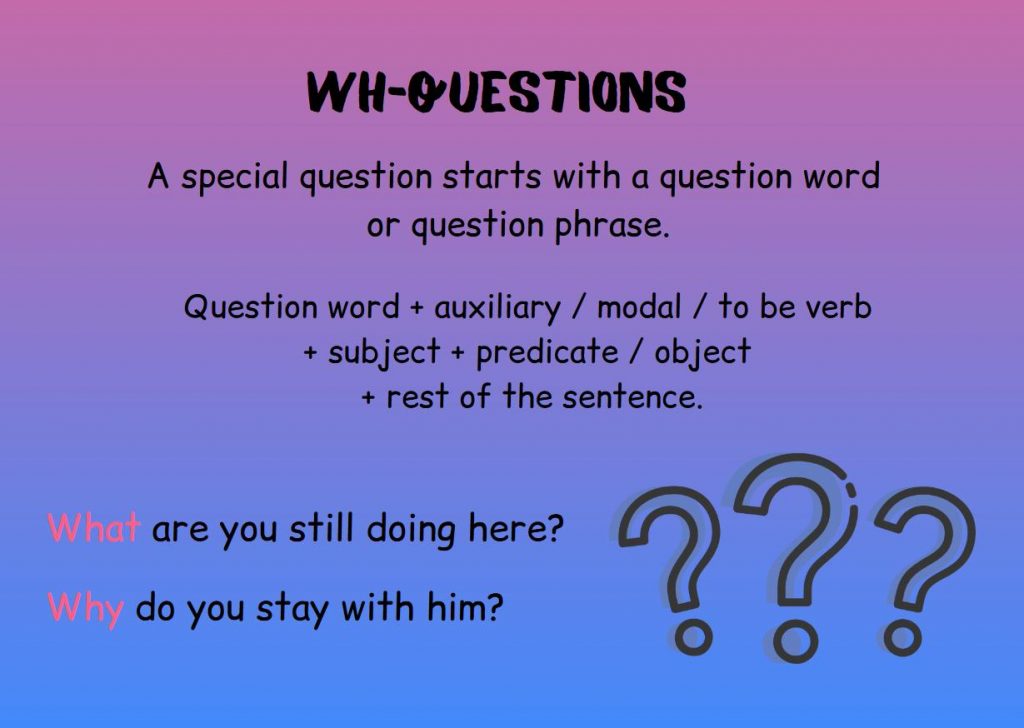
Questions to the subject in English
The next type of questions are Questions to the subject. We ask a question to the subject when we want to know WHO is performing the action.
Question: Who will go for a walk with you?
Answer: John.
Question: Who broke the cup?
Answer: Tom did it!Question: Who wants a slice of delicious pie?
Answer: I would not mind a piece of the pie …
The main feature of subject questions is that we don’t use any auxiliary verbs.
We just use the words Who or What instead of the subject.
If we ask a question to the subject in the Present Simple, then we add the ending -s to the main verb.
Question word + predicate + Secondary Parts of the Sentence
Who talks like that guy?
Who loves you?

Alternative questions
Another type of question that you should understand is alternative questions.
Why do we call these questions alternative questions? Because when we ask an alternative question, we not only ask but also offer alternatives for the answer! Doesn’t that sound interesting? Take a look at examples:
Do you like it or not?
Would you like tea or coffee?
We can ask an alternative question to any Parts of the Sentence.
Note the conjunction or in these examples. The conjunction or is an important feature of alternative questions.
It is the or that separates the answer options.
We form alternative questions almost in the same way as general questions.
Auxiliary verb + subject + action + answer option + or + answer option
Will you work at the central bank or one of its branches?
Alternative questions always have the or part.
Are you going to the cinema or the theater?
Have you played football or basketball?
If we want to use several auxiliary verbs in an alternative question, then we put the first auxiliary verb before the subject, and we put the remaining auxiliary verbs immediately after the subject.
Has John been working in this department or the next one?
We can easily turn an alternative question into a Wh Alternate Question (Special Alternative Question). To do this, we put a question word, or phrase at the beginning of the question:
Who do you prefer to work with John or Tom?
When did you decide to buy a new car, today or yesterday?
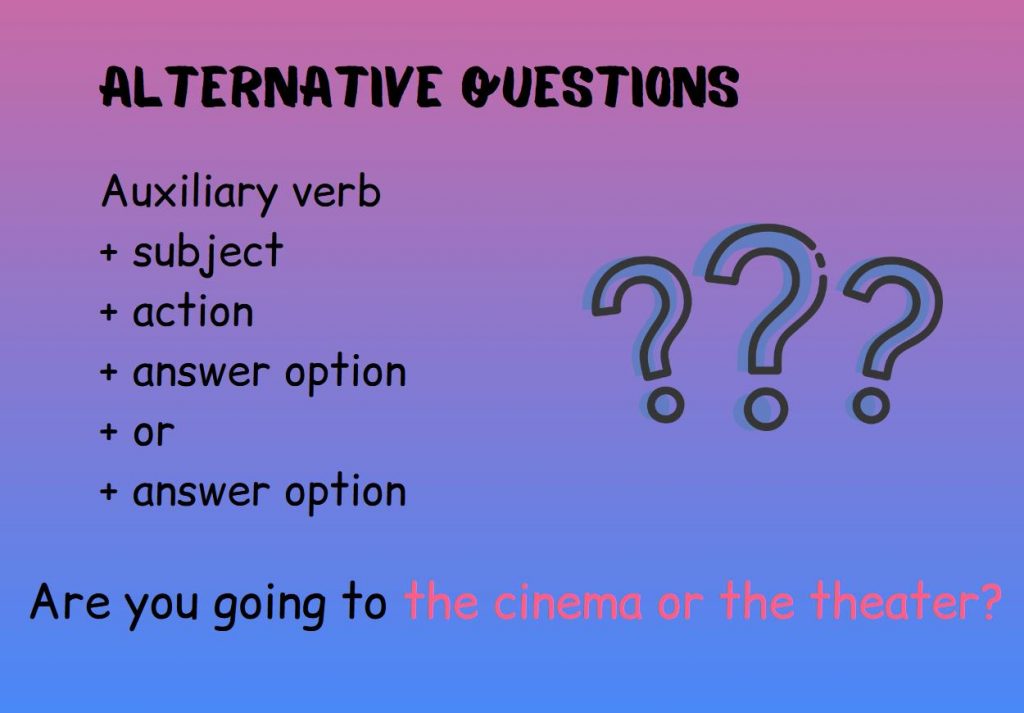
Tag Questions
Tag Question is a very interesting type of question in English.
For example, we ask General Questions just to get an answer (Often this is a simple yes / no answer). Often, when we ask a general question we do not know what the answer is.
When we ask a tag question, we often expect to hear confirmation of some information that we already know. That is, when we ask a tag question, we often know or mean what the answer is!
You’re going to see your grandmother, aren’t you?
You probably noticed that such questions do not look exactly like questions? Indeed, tag questions are more like affirmative sentences.
We DO NOT use question word order in tag questions. We use direct word order.
The main feature of this type of question is in the ending. The end of a tag question is called the tag. This is why we call them Tag questions.
You like her, don’t you?
To form such a tag, we put an auxiliary verb and the subject at the end of the sentence.
Any tag question has two parts:
- Affirmative or negative sentence.
- Tag at the end.
In the first part, we put what we think is the answer.
In the second part, we use the tag for confirmation.
He doesn’t want to talk to me, does he?
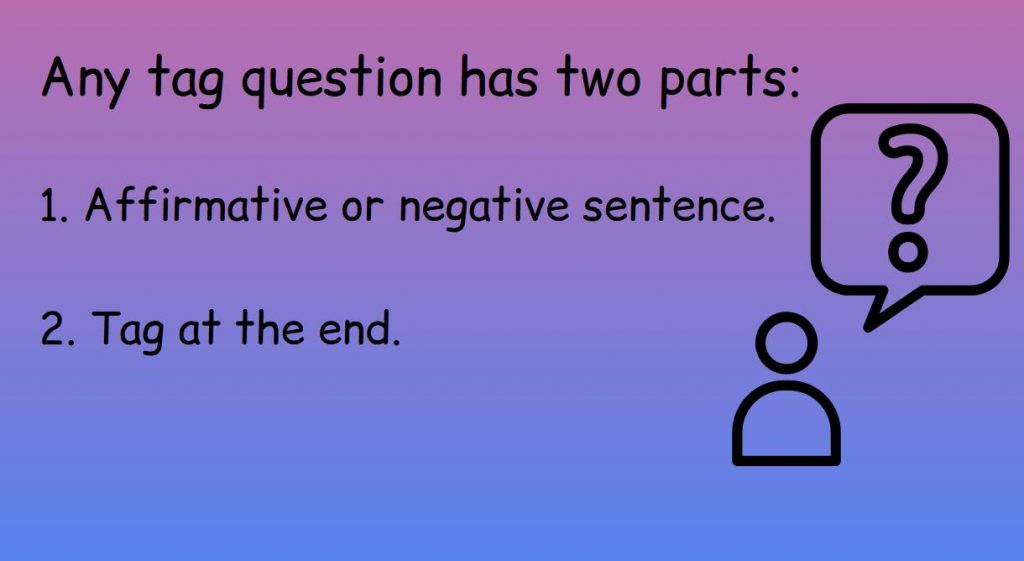
Tag questions are very popular and convenient in the English language. We use them all the time. We often ask tag questions to start a conversation.
We also use tag questions as a way to express feelings or emotions:
- surprise
- irony
- distrust
- skepticism
- doubt
etc.
He can’t beat me, can he?
They will help you, won’t they?
Janice doesn’t want to go to school anymore, does she?
We won’t be able to win this game, can we?
You better give up, don’t you?
If we form a tag question using the verb to have, then the end of the question can have several types:
British English: You have a new bike, have you?
American English: They have a new home, don’t they?
If we form such a question with the pronoun I, then:
- In the affirmative question, the auxiliary verb remains in the am form.
- In the negative form, the auxiliary verb changes to aren’t I. Because it is inconvenient to say am not.
Correct: I am not the perfect Princess, am I?
Correct: I am the perfect Princess, aren’t I?
Incorrect: I am the perfect Princess, am not I?
A tag question can be negative even if there is no negative particle not in the first part. Take a look at this sentence:
You rarely go outside, do you?
Note that the tag contains the verb do without the negative particle not. The first part of the sentence also has no negation. Why do we use do you instead of don’t you? Because the first part of the question contains the negative word rarely.
RULE: If the first part of a tag question contains a word with a negative meaning, then the tag part must contain a verb in a positive form.
Examples of negative words we often use:
- scarcely
- hardly
- rarely
- barely
- little
Etc.
You barely know him, do you?
We rarely work, do we?

Negative questions
There is another popular question type in English. These are Negative questions.
We can divide negative questions into two types:
Type 1: contracted negative questions
Type 2: uncontracted negative questions
We use Contracted Questions to express:
- a polite request
- criticism
- dissatisfaction
- remark
- invitation
Why don’t you get some more champagne?
Wouldn’t you object at this point?
Why don’t you take him shopping?
Contracted negative questions begin with words such as:
- Won’t you …?
- Wouldn’t you …?
- Why don’t you …?
We use the following word order in contracted negative questions:
auxiliary verb + ending n’t + subject
Take a look at examples:
Won’t you guys go up with me, please?
Why don’t you keep your thoughts to yourself?
Wouldn’t you like to refresh yourself?
Won’t you please reconsider my request?
Such questions are considered less formal.
If you want to give a positive answer to this type of question, you should answer: YES. In case of a negative answer, you should answer: NO.
Haven’t you read what I wrote?
Yes.Haven’t you been dreaming about this?
No.Haven’t you people heard anything?
No.

Now let’s look at uncontracted negative questions. Such questions are more formal than contracted negative questions.
We form uncontracted negative questions using the following scheme:
Auxiliary verb + subject + not
See how it looks with examples:
Why do you not tell them I am here?
Do you not recognize your own best friend?
Why do you not want to help me?
Have you not figured that out?
Has he not been true to his vow?
Are they not a shame on their country?
Do you not dare to face me?
Have you not seen The Voice?

I live in Ukraine. Now, this website is the only source of money I have. If you would like to thank me for the articles I wrote, you can click Buy me a coffee. Thank you! ❤❤❤
В русском языке чтобы превратить утверждение в вопрос достаточно изменить интонацию:
Газон нужно постричь. — Газон нужно постричь?
Вопросы в английском языке строятся по-другому, для их построения нужны:
- Вопросительная интонация.
- Перестановка слов в предложении.
- Вспомогательные глаголы (не всегда).
Всего выделяют пять видов вопросов в английском языке.
Виды вопросов в английском языке
В английском языке выделяют пять видов вопросов. В этой статье приведен общий обзор вопросительных предложений, более подробно читайте о них по ссылкам ниже:
- Общие вопросы – подразумевают положительный или отрицательный ответ.
- Специальные вопросы – начинаются с вопросительного слова: when? когда? what? что? и др., требуют развернутый ответ.
- Вопрос к подлежащему — разновидность специального вопроса, задается не к любому члену предложения, как специальный, а к подлежащему.
- Альтернативные вопросы — вопросы с «или», предполагающие выбор между двумя или более вариантами.
- Вопросы с «хвостиком» (tag questions) – это аналог вопросов с «не так ли?», «не правда ли?» в русском языке типа: «Хороший день, не так ли?»
1. Общий вопрос в английском языке
Общий вопрос подразумевает ответ «да» или «нет», либо более развернутый положительный или отрицательный ответ. Он строится по такой схеме:
| Вспом.модальный глагол | Подлежащее | Сказуемое | Другие члены предложения |
|---|---|---|---|
| Do | you | have | a cat? |
| Can | I | ask | you something? |
Как видите, на эти вопросы можно ответить «да» или «нет».
Приведу еще примеры с ответами.
Do you know this guy? — Yes.
Ты знаешь этого парня? — Да.
Could you do me a favour, please? — Sure, no problem.
Вы не могли бы оказать мне услугу? — Конечно, без проблем.
Do you need any help? — No, thanks.
Тебе нужна помощь? — Нет, спасибо.
Как видите, ответы не обязательно строго «yes» или «no», но они либо отрицательные, либо положительные.
2. Специальный вопрос
Специальные вопросы в английском языке требуют не общего ответа «данет», а более конкретного, они начинаются с вопросительных слов: кто? что? какой? где? и т. д. Специальные вопросы строятся по той же схеме, что и общие, порядок слов такой же за единственным исключением: в начале предложения ставится вопросительного слово (или группа слов): where, what, which, how, how long и др.
| Вопр. слово | Вспом.мод. глагол | Подлежащее | Сказуемое | Другие члены |
|---|---|---|---|---|
| What | is | your cat | doing | now? |
| What | can | I | do | for you? |
Приведу примеры специальных вопросов с ответами:
What is your cat doing now? — My cat is sleeping on the couch.
Что сейчас делает ваша кошка? — Моя кошка спит на диване.
How long did it take you to paint the portrait? — It took me two months.
Сколько времени у вас заняло написание этого портрета? — Это заняло два месяца.
3. Вопрос к подлежащему
Не во всех учебниках вопрос к подлежащему выделяется как отдельный вид, потому что он уж очень похож на специальный вопрос. Разница в том, что он задается не к любому члену предложения, а к подлежащему. Схема вопроса очень проста: вопросительное слово заменяет собой подлежащее.
Например:
- Утверждение: Sleeping makes your cat happy.
- Вопрос: What makes you cat happy?
| Вопр. слово | Сказуемое | Другие члены предложения |
|---|---|---|
| What | makes | your cat happy? |
| Who | saw | the fire? |
Примеры:
Who wants to be a millionaire? — I do.
Кто хочет стать миллионером? — Я хочу.
Who wanted to see me? — I wanted to see you.
Кто хотел меня увидеть? — Я хотел вас увидеть.
What made you change your mind? — Your speech.
Что заставило вас передумать? — Ваша речь.
4. Альтернативный вопрос
Альтернативный вопрос подразумевает выбор (альтернативу) между двумя или несколькими вариантами. Как и в русском языке, на них логически невозможно ответить «да» или «нет».
Do you prefer coffee or tea? – Вы предпочитаете кофе или чай?
I prefer tea – Я предпочитаю чай.
Можно ответить и коротко:
Do you prefer coffee or tea? – Вы предпочитаете кофе или чай?
Tea – Чай.
Альтернативные вопросы в английском языке могут начинаться и с вопросительного слова. В таком случае вопрос состоит из специального вопроса и следующих за ним двух однородных членов предложения, соединенных союзом or (или).
Which do you prefer: tea or coffee? – Что вы предпочитаете: чай или кофе?
5. Вопрос с «хвостиком» (расчлененный вопрос, Tag Question)
Еще один вопрос, подразумевающий положительный или отрицательный ответ, — это tag question, он же расчлененный или раздельный вопрос или, как его еще называют, «вопрос с хвостиком» (tag – хвостик, бирка).
Tag question — это утвердительное или отрицательное предложение, в конце которого добавляется «хвостик» – краткий общий вопрос, состоящий из местоимения и вспомогательного (или модального) глагола, который входит в состав сказуемого. Если сказуемое в форме Present Simple или Past Simple, то в кратком вопросе ставится do (does) или did.
В русском языке таким вопросам соответствуют вопросы с «не так ли?» или «не правда ли?» в конце.
You speak English, don’t you? – Вы говорите по-английски, не так ли?
Yes, I do. – Да, говорю.
You haven’t been here, have you? – Вы не были здесь, не так ли?
I haven’t – Не был.
Обратите внимание, что если «длинная часть» утвердительная, то «хвостик» с отрицанием и наоборот. В русском же варианте «хвостик» всегда одинаков.
You like this place, don’t you? – Тебе нравится это место, не так ли?
You don’tl ike this place, do you? – Тебе не нравится это место, не так ли?
Здравствуйте! Меня зовут Сергей Ним, я автор этого сайта, а также книг, курсов, видеоуроков по английскому языку.
Подпишитесь на мой Телеграм-канал, чтобы узнавать о новых видео, материалах по английскому языку.
У меня также есть канал на YouTube, где я регулярно публикую свои видео.
How to ask questions in English — all the subtleties
When we start building dialogues, we inevitably meet with questions addressed to ourselves or ask them to the interlocutor. Therefore, it is imperative to know how to ask questions in English in order to be able to support any conversation. And in this topic, several surprises await us, since there is a classification of English questions and each type has its own characteristics and structure of constructing a sentence. Everything in order.
Classification of questions
Interrogative sentences in English differ a lot from Russian ones, especially in the order of words in the sentence. Most English questions are formed using inversion (word rearrangement) and the use of auxiliary verbs.
The sentences have their own characteristics and are used in everyday communication by native speakers. There are 5 types of interrogative sentences in total:
- general questions (general)
- special questions (special)
- Disjunctive questions (separating)
- alternative questions (alternative)
- Questions to the subject (question to the subject)
How to ask questions in English
Scheme for constructing an interrogative sentence
General questions
Reverse word order is used to form such questions. This means that we put the auxiliary verb first, the subject second, and the main verb third.
- Tom s swimming in the sea… — Does (auxiliary) Tom (subjects) (main verb) swimming in the sea?
- She goes to work everyday… — Does (auxiliary verb) she (subjects) go (main verb) to work everyday?
Common questions are also built with modal verbs. In this case, the modal verb will replace the auxiliary, that is, it will be placed in the first place.
- Mold you close the door, please? — Could you close the door, please?
- May I come in? — May I come in?
- Should I put on sweater? — Should I wear this sweater?
We draw your attention to the verb to be. We can safely consider it special — in general questions, you do not need to add an auxiliary verb to it.
- Is he a teacher? — He is a teacher?
- Was the weather good yesterday? — Was the weather good yesterday?
We form a negative general question.
To do this, you need to add a particle Note… It will stand right after the subject. However, if we use the shorthand not — n’t, it will come before it. Let’s see an example:
- Does she not go to work on Sunday? = Doesn’t she go to work on Sunday? — She doesn’t go to work on Sunday?
- Have you not watched this movie? = Haven’t you watched this movie? — Have you seen this movie?
Special Issues
The word «special» means intended solely for something. Accordingly, this question is needed to find out the specific information you are interested in. Therefore, it is called special, that is, you want to clarify special information.
For example:
- Where are you going to rest? (We will find out specific information — the place where the person will go.)
How to build a custom question?
It is asked using the following interrogative words:
- what — that
- Where — where
- When — when
- who — who
- why — why
- how (much / often / long) — how (much / often / long)
These words are put in the first place, and then the sentence is built, as in a general question.
Word construction scheme: Question word + auxiliary verb + character + action being taken?
Examples:
- When did he get up? — When did he wake up?
- Where will you go? — Where will you go?
- Why do they travel? — Why do they like to travel?
Separation issues
A dividing question is a type of question that expresses doubt, surprise, or confirmation of what has been said.
The dividing question is formed by adding a short phrase with an auxiliary verb to the usual affirmative sentence, giving the entire sentence a doubt. The Russian equivalent of the dividing question is “is not it?»
In English, in order to correctly compose this short dividing part, you need to carefully study the sentence itself. If the sentence is affirmative, then the dividing part will be negative, and vice versa, if the sentence is negative, then the dividing part will be affirmative.
The dividing question is formed with the help of an auxiliary verb used in a sentence and a pronoun that could replace the subject of this sentence. Let’s take a look at examples:
- John is a good student, isn’t he? — John is a good student, isn’t he? (the sentence is affirmative, so the dividing part is negative)
- Linda is the most beautiful girl in the class, isn’t she? “Linda is the prettiest girl in the class, isn’t she?
- Jamie’s parents aren’t from Spain, are they? “Jamie’s parents are not from Spain, are they?
- We aren’t going to London tomorrow, are we? “We’re not going to go to London tomorrow, are we?
- It will be the best summer in their life, won’t (will not) it? “This will be the best summer of their lives, won’t it?
- He can climb any tree, can’t he? “He can climb any tree, can’t he?
We already know that all English verbs, with the exception of to be and modals, build questions using the auxiliary verbs do, does, or did (if we are talking about the past).
For example:
- You don’t your neighbors, do you? — You don’t love your neighbors, do you?
- He s his friend’s sister, doesn’t he? — He loves his friend’s sister, doesn’t he?
- They found a new babysitter, didn’t they? “They found a new nanny, didn’t they?
As you can see from the examples, all dividing questions are asked with the aim of expressing doubt, surprise, or to find confirmation of what was said.
Alternative questions
True to its name, this question suggests an alternative, that is, the right to choose. By asking it, we give the interlocutor two options to choose from.
Example:
- Are you flying to England or Germany?
There is always a union in such a matter or (or). The question itself is built as a general one, only at the end with the help of our or we add a choice clause.
Scheme for constructing an alternative question: Auxiliary verb + character + action to be performed + ___ or ___
Examples:
- Will they go to the park or to the cinema? — Will they go to the park or to the cinema?
- Did you buy an apples or pears? — Have you bought apples or pears?
- Does he work or study? — Is he working or studying?
Questions to the subject
Question to the subject — this is a special category of questions in which it is not necessary to change the direct order of words, i.e. it remains the same as in a regular declarative sentence. Thus, this is the only kind of question where there is no need for auxiliary verbs and there is no inversion (permutation of the members of the sentence).
For example:
- Who came to the party? — Who came to the party?
- What happened at the end? — What happened in the end?
- How many students arrived to the lesson? — How many students came to the lesson?
Order of words in a sentence: Subject — Predicate — Object
Often questions to the subject begin with interrogative words. who ?, what ?, how many / how much? The meaning of the question to the subject lies in the fact that interrogative pronouns in it play the role of a subject.
For example:
Who is taliking to you? — Who speaks to you?
There is nothing difficult to ask a question and find out the information of interest. Now you know how to ask questions in English and take into account all the subtleties and nuances. Learn English, be curious, and ask the right questions to your interlocutors.
Source: https://englandlearn.com/grammatika/kak-zadavat-voprosy-v-anglijskom-yazyke
Types of questions in English
After watching the video, you can check the correctness of your answers here
Questions in English can be divided into 5 types
| — General questions | Questions that do not contain interrogative words (ie without the words “what”, “what”, “where”, “when”, “why”, etc.) |
| — Special Issues | Questions containing interrogative words. |
| — Questions to the subject | Questions with the word «who-who». |
| — Inverted questions | Questions asked by word rearrangement. |
| — Separation issues | Questions that clarify: «right?» or «so?» |
Of all five types of questions, only one type of it (questions to the subject) is constructed in the same way as in Russian. In other cases, the question is asked using verbs. A Russian-speaking person does not intuitively feel the need to use them, so you need to remember thatin English, the question always starts with a verb: — do (does), did or will; — if the declarative sentence contains the verb be, have or a modal verb), then the question is asked using the inversion (i.e. the auxiliary verb moves to the beginning of the sentence). See the structure of the interrogative sentence in English language will help the following table.
Questions in English
type of questions — general questions… These are questions asked without interrogative words (ie without the words “what”, “where”, “when”, etc.).
| You live in Moscow. | Do you live in Moscow. | |
| Do | you live in Moscow? | Do you live in Moscow? |
| He lives in London. | He lives in London. | |
| he live London? | He lives in London? | |
| They visited the USA. | They visited the United States. | |
| Did | did they visit the USA? | Have they visited the USA? |
Other examples on the page — general questions in English
type of questions — special. These are questions that use interrogative words. Examples of question words: where — where why — why when — when how — how what — what, which which — which of Special questions are constructed from general questions, adding any question word.
| Where | do | you work? | Where do you work? |
| Where | did | you work? | Where did you worked? |
| Why | does | she prefer them? | Why does she prefer them? |
| Why | did | she prefer them? | Why did she prefer them? |
| When | did | they go there? | When did they go there? |
| How | does | he make it? | How does he do it? |
| How | did | he make it? | How did he do it? |
| What | do | you? | What do you like? |
type — questions to «who — who» (or questions to the subject).Questions with all interrogative words are structured in the same way. An exception is the question with «who — who», in English it sounds the same as in Russian.
| Who | moves in New – York? | Who is moving to New York? | |
| BUT NOT!!! | |||
| Who | does | move in New – York? | |
| Who | moved in New – York? | Who Moved to New York? | |
| BUT NOT!!! | |||
| Who | did | move in New – York? |
More examples of who-who questions on the English Question Words page.
type — inverted questions (questions formed by rearranging words in places). If a declarative sentence has an auxiliary verb, then the question will be asked using an inversion. There are only 3 types of such proposals: — questions in the future tense (questions with will); — questions with modal verbs; — with the verb «be».
| You will stay there. | You will be there. |
| Will you stay there? | Will you be there? |
| He can do it. | He can do it. |
| Can he do it? | Can he do it? |
| She is tall. | She (is) tall. |
| Is she tall? | Is she (is) tall? |
Other examples of questions with «be» and modal verbs are on the Inversion in English page.
Future tense english
Modal verbs in English table
The verb to be in the present simple
type of questions — dividing (questions-re-asking) This type of questions is quite rare in practice. It is not necessary for the ability to speak, but it is necessary for understanding English speech. The construction of dividing questions is carried out using the words «whether» and «not so».
| He drinks coffee, doesn’t he? | He drinks coffee, doesn’t he? |
| She is beautiful, isn’t she? | She’s beautiful, isn’t she? |
| She is not beautiful, is she? | She’s not pretty, is she? |
Other examples of how to ask dividing or alternative questions in English
English questions are included in the list of the most important sections of English grammar. Without the ability to ask questions, it is impossible to learn to speak. Therefore, it is necessary to bring the ability to use all types of questions in English to automatism. The audio simulator on the Learn English Online page will help you do this. The simulator gives examples of the most common phrases.
Questions raised in the video
| 1. | You live in Russia? | Do you live in Russia? |
| 2. | Are you a Russian woman? | Are you Russian? |
| 3. | Have you made a reservation? | Did you make a resevation? |
| 4. | Are they going to Mexico? | Will they go to Mexico? |
| 5. | He is sick? | Is he sick? |
| 6. | Have you ever skied? (Have you ever skied downhill? | Have you ever skied down hill? |
| 7. | Are they back from vacation yet? | Did they come back from vacation? |
| 8. | Would you like to sit by the window? | Would you to sit by a window? |
| 9. | Do you have a visa? | Do you have a visa? |
| 10. | Would you like fish or meat? | Would you meat or fish? |
Source: https://audio-english.ru/tipy_voprosov_v_anglii_skom_yazyke.html
»Blog» How to ask questions in English table
Being able to compose questions in English is an important aspect in learning a language. This topic seems simple and easy, but some nuances stand out. How to cope with them and learn how to correctly formulate questions in English, you will learn in this article.
Stages of writing questions in English
For grammatically correct compilation of questions in this foreign language, a clear, and most importantly, simple scheme was created:
- Find a verb in a sentence and understand what it is (basic, modal or to be).
- Correctly determine the tense of this verb (knowledge of the tense is required).
- We apply the rule of composing questions (the same for almost all types) — either rearrange the verb in the first place, or use an auxiliary verb.
General formula: interrogative word + auxiliary verb + subject + predicate + other members of the sentence?
Example:
- A cat s milk. — The cat loves milk. (affirmative sentence).
- Does a cat milk? — Does the cat like milk? (interrogative sentence).
Writing questions requires knowledge of verb tenses, modal verbs, and equivalents.
5 types of questions in English
There are five types of questions in English:
- General;
- Alternative;
- Separating;
- Special;
- Question to the subject.
Past tense
General questions of the past tense are compiled according to the standard formula, but with some modifications.
Source: https://englishunlimited.ru/blog/kak-zadavat-voprosy-v-anglijskom-yazyke-tablica.html
Types of questions in English in pictures and with examples
Can you imagine your life without question. Every day we ask and answer dozens of questions: «How to get to the pharmacy?», «What time is it?», «How much is this magazine worth?»
Our overview article will focus on the five main types of questions in English and how to write questions in English. After all, each of them has its own grammatical features, structure and word order in the sentence. In addition, we will provide useful examples of questions in English with translation, which will help you to understand this topic in more detail.
We also recommend that you familiarize yourself with the selection of English courses for beginners if you want to start speaking and understanding the language faster.
Types of questions in English
In English, there are 5 ways to ask a question. Their type will depend on the situation: you want to confirm the information you have, collect details, ask out of courtesy, etc.
1. General questions.
If the question implies a monosyllabic answer — «yes» / «no», then it belongs to this category.
The formula for such a question will look like this:
auxiliary or modal verb + subject + predicate + rest of the sentence
The verb «to be» does not need auxiliary verbs, provided that it is used in the present or past tense.
examples:
- Do you live in Ekaterinburg? — Yes, I do. — Do you live in Yekaterinburg? — Yes.
- Will you be at university day after tomorrow? — Yes, I will. — Will you be at the university the day after tomorrow? — Yes.
- Are you a volleyball player? — Yes, I am. — Are you a volleyball player? — Yes.
- Can you read this book? — Yes, I can. — Can you read this book? — Yes I can.
2. Separation questions (questions containing ponytails).
Such interrogative constructions consist of two parts: an affirmative and an interrogative, which acts as a «tail». If the first part is affirmative, then the second is negative. And vice versa.
Similar questions are asked when they want to clarify details, check information; express approval or vice versa — distrust, induce the interlocutor to respond. They also help to express your own emotions: — distrust, ridicule, politeness, sarcasm, doubts, etc.
examples:
- You speak Japanese language, don’t you? — You speak Japanese, don’t you?
- You didn’t go to the hospital day before yesterday, did you? “You didn’t go to the hospital the day before, did you?
- His girlfriend worked in medicine, didn’t she? “His girlfriend worked in the medical field, didn’t she?
Source: https://enguide.ru/magazine/tipy-voprosov-v-angliyskom-yazyke-tablica-s-primerami
Subject question in English
In order to ask a question to a subject in English, you must first understand 3 things: what is the subject (the main member of the sentence, answers the question who? What?), What types of questions are there in English and how to compose these questions in English.
A special question for a subject in English. Structure
1. My colleague is writing a report in the office.
Subject Predictable Complement Circumstance
| Who | is writing | a report | at the office? |
| Who writes the report in the office? |
2 students came to school.
Subject Predictable Complement Circumstance
| How many pupils | came | to school? |
| How many students came to school? |
3. Porridge is burning in the kitchen.
Subject Predictable Complement Circumstance
| What | is burning | in the kitchen? |
| What’s burning in the kitchen? |
Negative form of subject questions in English
The negative form of questions to the subject in English is built on the principle of negative sentences, that is, the auxiliary verbs do, does, did are used. We put the NOT particle after the modal or auxiliary verb.
4. This student hasn’t answered my question yet.
Subject Predictable Complement Circumstance
| Who | hasn’t answered | my question yet? |
| Who hasn’t answered my question yet? |
5. Kate doesn’t speak English.
Subject Predictable Complement Circumstance
| Who | doesn’t speak | English? |
| Who doesn’t speak English? |
How to formulate a subject question in English?
- Find a subject in a sentence.
- Replace it with a suitable interrogative pronoun
— Who? (who?) or What? (what?). - Maintain direct word order, while leaving all members of the sentence in their places.
- When composing a question for a subject in English, remember to reconcile the verb with the subject — in Present Simple we use the verb in the third person singular. — add the ending -s (es) to
verb (eg Who wants tea?).
Questions to determine the subject in English:
- What film is the best? What’s the best movie?
- How many students attend lectures? How many students
attends lectures?
Example 1
John is going to England next week.
1. Subject — John
2. Replace John with who
3. Maintain direct word order (that is,
subject + predicate)
Question to the subject: Who is going to england
next week? Who’s going to England next
week?
Example 2.
Viktuk’s play was staged.
Questions to the subject:
Whose play was staged?
Whose play was performed on stage?
What was staged? What did you do on stage?
Example 3.
The girls are happy.
Question to the subject: Who is happy? Who
happy?
Example 4.
We were in the circle.
Question to the subject: Who was in the circle?
Who was in the circus?
Example 5.
We were in the circle.
Question to the subject: Who was in the circle?
Who was in the circus?
Exercise 2. Compare pairs of sentences, find the subject in each sentence, determine which of the questions is a question to the subject — a) or b), translate the sentences into English. In one of the pairs, both sentences are questions to the subject.
- a) Who will you go with? versus b) who will go
with you? - a) What does he do? versus b) Who does it?
- a) Who thought about his health? versus b) What did he think about?
- a) Whose car did you scratch? versus b) Who
scratched your car? - a) Which girl has served dinner? versus
b) Who has to serve dinner?
- a) Who will you go with? Who are you going with? versus b) Who will go with you? Who will go with you? b) — question to
subject to
- What does he do? What does he do? versus Who does it?
Who is doing this? b) — a question to the subject - Who thought about his health? Who thought about their health? versus What did he think about? What is he talking about
thought? a) — a question to the subject
- a) Whose car did you scratch? Whose car did you scratch? versus b) Who scratched your car? Who scratched your car? b) — question to
subject to
- Which girl has served dinner? Which of the girls served dinner? versus Who has to serve dinner? Who Should Serve Dinner? a) and b) — questions to
subject to
Exercise 3: Correct the mistakes
- Who to sing?
- Who did was in the park?
- What does make you think so?
- Who did see the accident?
- What does washing need?
- Who did make you feel disappointed?
- Who’s to sing (singing)?
- Who was in the park?
- What makes you think so?
- Who saw the accident?
- What washing needs?
- Who made you feel disappointed?
Exercise 4. Translate into English
- Who writes articles about animals?
- Who upset you?
- What’s next to the language school?
- What scared your little son?
- Who prompted her to do this?
- Who didn’t go to the party?
- Who is cold (hot)?
- Who usually does the dishes in your family?
- What influenced his decision?
- How many letters did you receive in the afternoon?
- Who writes articles about animals?
- Who disappointed you? (Who made you feel
disappointed?) - What is near the language school?
- What scared your little son?
- Who influenced her to do that?
- Who didn’t go to the party?
- Who is cold (hot)?
- Who washes up in your family?
- What influenced his decision?
- How many letters arrived in the afternoon?
Subject question in English
Source: http://blog.englishvoyage.com/vopros-k-podlezhashhemu-v-anglijskom-yazyke/
How many types of questions are there really in English? Understanding
Hello my dear readers.
Russian-speaking people rarely ask themselves a question of terminology. Here we do not like these complex words and that’s it. But those who have to learn English are faced with this much more often. An example of how we can know a rule, but not know its name, are the types of questions in English.
There is hardly a student who can easily name all the variations with examples. Well, let’s fix it. Today we are waiting for an interesting theory with explanations, tables and examples, followed by an equally interesting practice.
:
Let’s start in order.
General
The general question is the most common. That’s why it is common, as they say. The answer will always be «yes» or «no.» Of course, then the answer can be expanded and supplemented, but confirmation or denial is the basis.
I have already written about this topic in as much detail as possible in a separate article on general issues. But still, let’s remember with examples.
—Are you going to the cinema tonight? — Are you going to the cinema today?
—Yes, I am. — Yes.
And one more example.
—Are they our new neighbors? — Are these our new neighbors?
—Yes, they are.
Special
A special question always starts with a specific question word. Its main purpose is to obtain more detailed information. The most common interrogative words in speech include:
- Whom — Whom
- When — When
- Whose — Whose
- Which — Which the
- Where — Where
- Why — Why
- How — How
- And others (more about them in the article)
The ad-hoc question follows a simple structure:
Question word + auxiliary verb + subject + predicate main verb + object.
When did the bell ring? — When did the bell ring?
Where did they go? — Where did they go?
Interestingly, this type is divided into two groups:
- Questions to the whole offer
- Questions to the subject.
You can learn more about the latter in another article. But we will talk about the first group in great detail here. Their main difference is the word order. Let’s find out by examples.
Who goes to the theater tomorrow? — Who goes to the theater tomorrow? This is a subject matter.
When did you break the plate? — When did you break the plate? This is already a question for the whole proposal.
The difference lies directly in the word order. If in the first sentence the order remains direct, then in the second an inversion occurs: an auxiliary verb is immediately written, and then a pronoun.
To make it clearer, let’s rephrase the second sentence.
Who broke the plate? — Who broke the plate?
Separating
The dividing question is most often known by schoolchildren as the «tail». It is usually taught somewhere in the 6th grade and this is perhaps the favorite topic of any student. His main task is to check any assumption, express doubt, or simply confirm his thought.
It consists of two parts: an affirmative part and a question, that is, a tail. We can see its structure right away with an example.
Source: https://lizasenglish.ru/grammatika/tipy-voprosov-v-anglijskom.html
The use of prepositions in English
What I love about English prepositions is the ability to completely change the meaning of the main word with the help of one such small word. It was «look at», but now:
• «look for»
• «to have an opinion» (look upon)
• «look after»
• «forgive» (look over)
• «look to».
Juggling with English pretexts is aerobatics. If you learn this art, you will enrich your vocabulary and generate a buzz of approval with your speech.
Many English learners take pretexts with some arrogance, believing that it is like a student repeating the English alphabet at night. Underestimated. But in vain.
Yes, prepositions are considered official, they do not answer any questions, but they allow you to get different meanings from the same verb, form cases (yes, the same ones that are in Russian) and do other interesting things. There is only one problem: there are a LOT of prepositions in English.
But this does not mean that you need to learn all of them right here and now. It is enough only to know the main ones, as well as to understand the division into groups.
Let’s not waste time on the fact that prepositions are simple monosyllabic, polysyllabic, consisting of several words, blah blah blah. Let’s get down to business and provide not only tables of prepositions in English, but also illustrative examples in pictures. We will also consider the use of prepositions with examples.
1. Prepositions of place and direction (spatial)
It is better to see once than to read the synopsis 100 times:
2. Temporary prepositions
Let’s consider the most basic ones: about, after, at, during, for, in, on, till, within.
| about | about (about, about) | It’s about 6 pm |
| after | after | Summer comes after spring. (Summer comes after spring) |
| at | в | Let’s meet at 10 am |
| During | for | She was sleeping during the whole lesson. (She slept throughout the lesson) |
| for | for | He laughed for 5 minutes. (He laughed for 5 minutes) |
| in | via | I’ll be home in 10 minutes. (I’ll be home in 10 minutes) |
| on | by | I usually go shopping on Fridays. (I usually go shopping on Fridays) |
| to | to | I won’t go shopping till Sunday. (I won’t go shopping until Sunday) |
| Within | within, for | You must do it within a month. (You have to do it in a month) |
because of — because;
on account of — due to, due to;
thanks to — thanks;
in accordance with — according to, in accordance with.
As you can see, the same preposition can be in different groups (for example, in or on are both temporal and spatial). Moreover, if you open any dictionary (well, at least the same Yandex) and select any preposition, you will be surprised at the number of meanings. Let’s say the most commonly used English preposition to can have 13 values (do not be lazy, take a look).
Let’s talk a little about the nuances before inviting you to go into battle the «tests» section, where the first linguistic tests for knowing prepositions await you.
SINGING OFFERS!
Yes, yes, to sing along or even read out. When you get acquainted with the basic excuses, try yourself in the role of Eminem, Timati, or any rapper you like. Not enough ideas for the text yet? Mix up prepositions! Knowing small and remote prepositions is very cool. Check it out by watching the video and feel like a rising rap star.
ENGLISH PROSPECTS AND RUSSIAN PADES. We remember the second class.
• Genitive case (who? What?) — preposition of
Show me the plan of the house.
• Dative case (to whom? What?) — preposition to
Give it to me.
• Accusative case (who? What?) — no preposition
Give me a pen.
• Instrumental case (by whom? What?) — preposition With
She was cutting the letter with scissors.
• Prepositional case (about whom? About what?) — preposition about
Don’t speak about me.
PLACE OFFER IN OFFER
Any excuse, know your place!
• In general, the preposition is supposed to be put BEFORE a noun or pronoun (if the noun has an article or a definition, then you cannot break it)
Put the book on the table.
Give it to me.
The shop is behind the green house.
You must do it with in two months.
• In interrogative sentences (which start with what, where, etc.), the preposition is placed at the end:
What city do you live in?
Who are you waiting for?
• The rest of the cases are associated with the use of prepositions in subordinate clauses, passive constructions. All this will be more relevant to study in the «Syntax» section.
• It is very useful to learn the signs, where the preposition has already merged with a certain noun. Useful in everyday communication.
| by | By mistake By accident By chance By the way By bus / train / car day by day Step by step |
by mistake by accident by accident by the way by bus / train / car day after day
step by step |
| for | For a walk / dance / drink / swim For breakfast / dinner |
go for a walk / dance / drink / swim for breakfast / lunch |
| in | in fact In case In the future In love In time In the morning / evening / afternoon |
in fact in case in the future in love at the right time
morning / evening / afternoon |
| on | On-television On holiday / a trip on foot |
on TV on vacation / on a trip
on foot |
| at | At home / work At night At present |
at home / at work at night
now |
By the way, about the last three pretexts. They won a special place under the sun and formed their own caste — prepositions of place. Why it is necessary to collect a dossier on them no less than on a counterintelligence agent, an article specially devoted to them will tell and prove.
Simple valuable advice: since it is impossible to learn ALL prepositions at the first time of learning (and it is not necessary), when you write out the next new verb from the dictionary, mark yourself at least 2 options with different prepositions.
For example:
Put — put
Put on — to place a bet on (smb., Sm.)
Put across — to deceive
When it becomes a habit, you will one day be happy to find that the use of the verb is masterful: in different meanings for the situation. This will brighten your speech and save you from any pauses and «mmm», «eee», «aaa». In the meantime, the problem exists, then you need to solve it, starting with passing a thematic test on prepositions.
Have you sorted the prepositions on the shelves in your head? There are spots even on the Sun, so we suggest once again (which is not at all superfluous) to go through the pretexts by watching a video tutorial on the topic. After watching and several years of practice, you can safely assign yourself the honorary title of «guru».
Source: https://iloveenglish.ru/theory/anglijskaya_grammatika/predlog
Any questions?
Вопросы есть?
Конечно, у вас есть вопросы: английский язык, бывает, задает задачки. Например, как составлять вопросы на английском? Какие бывают виды вопросов? Как задать вопрос с правильной интонацией, чтобы носителям языка не пришлось гадать — это вопрос или нет?
Итак, 5 видов вопросов в английском языке:
Общие вопросы, или yes/no questions
Специальные вопросы, или WH questions
Альтернативные вопросы
Разделительные вопросы, или tag questions
Вопросы к подлежащему
Рассмотрим подробнее все типы вопросов с примерами.
Общие вопросы — это такие вопросы, на которые можно ответить либо да, либо нет (еще можно ответить «не знаю», но это же не про нас).
Do you like opera? — No, I don’t.
Ты любишь оперу? — Нет, не люблю.
Are you a football player? — Yes, I am.
Ты футболист? — Да.
Общие вопросы всегда начинаются с глагола. Это может быть один из вспомогательных глаголов (be, do, have), может быть глагол to be (быть, являться) в его прямом значении, а может быть и модальный.
Как задать YES/NO вопрос с глаголом to be
Образование вопросов в английском языке становится возможным благодаря изменению структуры предложения. Если вам известна самая элементарная структура предложения в английском (подлежащее-сказуемое-дополнение) — вы сможете задать такой вопрос. Просто поменяйте местами подлежащее и сказуемое.
Посмотрите, как меняется место глагола to be в вопросе:
Заметьте, что в русском переводе ничего не меняется — мы вопрос привыкли обозначать интонацией, и инверсии — изменения порядка слов в предложении — у нас нет, или встречается редко.
Как задать такой вопрос на английском с помощью глагола to do
Помимо to be в предложении может быть любой другой глагол:
The fish swims in the ocean — Рыба плавает в океане
My friends play football — Мои друзья играют в футбол
I sing opera — Я пою оперу
И тогда нужно использовать глагол-помощник DO
Does the fish swim in the ocean?
Do my friends play football?
Do I sing opera?
Слова с такой функцией в русском нет. Мы говорим просто: Рыба плавает в океане? Стоит заменить знак вопроса на точку, как смысл меняется радикально. Удобно? Может быть. Но отнеситесь к вспомогательному do снисходительно. Он старается изо всех сил. Видите, как он забрал у глагола swim окончание -s? Это чтобы нам с вами было сразу понятно, что речь про одну единственную рыбу. Да и вообще, это как маячок: слышишь do в начале предложения — жди общий вопрос.
Так что ставим глагол do в начало предложения перед подлежащим, и общий вопрос готов. Только нужно выбрать правильную его форму в соответствии с числом и временем.
Если смысловой глагол — тоже do (делать), то вспомогательный все равно будет do. Получится два слова do в одной фразе:
Does she do her homework? — Делает ли она свои домашние задания?
Еще раз обратите внимание, что вспомогательный глагол do изменился в соответствии с женским родом — превратился в does, а смысловой остался в начальной форме.
Как задавать вопросы в английском с модальными глаголами
Я имею возможность купить козу. Но не имею желания.
(из фильма «Кавказская пленница»)
Модальные глаголы — это такие глаголы, которые выражают наши желания и возможности. Это глаголы can, may, must, should и другие. Задаем вопросы с ними при помощи инверсии, т.е. меняем местами подлежащее и сказуемое.
+
You can buy a goat.
Ты можешь купить козу.
?
Can you buy a goat?
Ты можешь купить козу?
Также модальные глаголы очень часто используются, когда задавать прямой вопрос не очень вежливо.
Could you pass me the salt? — Не могли бы вы передать мне соль?
Would you do me a favor? — Не могли бы вы сделать мне одолжение?
May I come in? — Я могу войти?
Should I wait here? — Нужно ли мне подождать?
Как отвечать на общий вопрос?
Как известно, на вопрос иногда можно получить ответ, и вот тут важно не растеряться и понять его. Чаще всего, сначала это будет обычный короткий ответ, а после него уже могут следовать подробности.
Yes, I do, или:
No, I don’t.
Или:
Yes, it is
Yes, I can
Какой глагол будет использоваться в ответе, напрямую зависит от вопроса. Если вопрос содержал вспомогательный do, то и в ответе будет do. Если у вас спросили:
Did you go the supermarket yesterday? — Вы ходили вчера в супермаркет?
Нужно ответить
— Yes, I did, или
— No I didn’t
В крайнем случае,
— I don’t remember
— Я не помню
Но не допускайте такую ошибку:
— Did you go to the supermarket yesterday?
Не отвечайте
— No, I wasn’t.
Нужно, чтобы ваши с собеседником глаголы совпадали, тогда у вас будет полная языковая гармония и понимание.
Зачем вообще эти короткие ответы? Так быстрее и удобнее. Вместо того, чтобы говорить «Yes, I went to the supermarket yesterday», можно просто сказать «I did». И это не звучит резко, даже если вы больше ничего не скажете, хотя, конечно, частенько за этим следует более подробный рассказ.
Специальные вопросы, или WH questions
Я спросил у ясеня where is my любимая
Как видно из английского наименования, специальные вопросы — это те, которые начинаются на буквы wh.
Например,
Where — где?
Who — кто?
What — что?
Which — который?
When — когда?
Why — почему?
How — как?
и вопросы, имеющие в своем составе «how»:
how often — как часто?
How far — как далеко?
How old — чтобы спросить о возрасте
И так далее.
Таким образом, WH questions включают в себя Wh questions + How
Where is my darling? — Где моя любимая?
Те из вас, кто уже умеет задавать общие вопросы, удивятся, когда узнают, насколько просто формируется специальный вопрос в английском.
Рассмотрим его строение на примере:
Why do you like swimming? — Почему ты любишь плавать?
Если мы уберем вопросительное слово why, получится
Do you like swimming?
Это обычный общий вопрос, который требует ответа «да» или «нет». Мы добавили why, и получился специальный вопрос.
Давайте немного потренируемся. Сделайте из следующих общих вопросов специальные, добавив к ним любые вопросительные слова.
- Does she go tho the supermarket?
- Can I buy a goat?
- Should I wait here?
- Do your friends play football?
- Does she do her homework?
- Are you waiting for me?
Наверное, у вас получилось что-то вроде этого:
- When does she go tho the supermarket?
- Where can I buy a goat?
- Why should I wait here?
- How often do your friends play football?
- When does she do her homework?
- Where are you waiting for me?
Вопрос к подлежащему
Во многих британских учебниках этот вид вопроса отдельно не выделяют и относят к группе специальных вопросов. Да, вопросы к подлежащему тоже начинаются с вопросительных слов, которые начинаются с Wh.
Но многие рассматривают именно пять типов вопросов в английском языке, потому что вопрос к подлежащему имеет очень простую структуру, чему, конечно, нельзя не порадоваться.
Когда мы задаем вопрос к подлежащему, то вспомогательный глагол не нужен. Инверсия тоже не нужна. Посмотрите на пример:
Bulgakov wrote «Master and Margarita» — Булгаков написал «Мастера и Маргариту».
Подлежащее — Булгаков. Он в этом предложении действующее лицо, он написал роман. Допустим, мы не знаем этого известного факта и хотим задать вопрос к подлежащему: Кто написал «Мастера и Маргариту»?
Для этого вместо подлежащего вставляем who. Получается,
Who wrote «Master and Margarita»?
Все, больше ничего делать не нужно, вопрос готов. Можно не вспоминать про правила, а просто переводить слово в слово, потому что в русском эта структура выглядит так же:
Кто читает книги?
Who reads books?
Какой город является самым большим?
Which city is the biggest?
Кстати, почему в примере «Who reads books?» у глагола окончание s? Дело в том, что, задавая вопрос «Кто?», мы всегда подразумеваем третье лицо единственного числа, даже если на самом деле действующих лиц много.
В русском мы делаем то же самое:
Кто читает? (читает – глагол с окончанием 3 лица, единственного числа).
Таким же образом поступаем и в present perfect:
Альтернативные вопросы
Это любые вопросы, в которых дается альтернатива и есть разделительный союз. Выбор может быть между предметами, действиями, качествами и т.д. С точки зрения структуры, это два общих вопроса, разделенные союзом or (или). Вторая часть чаще всего неполная:
Are you married or single? — Вы замужем или нет?
Do you work or study? — Вы работаете или учитесь?
Do you like classical music or jazz? — Вы любите классическую музыку или джаз?
В русском такая конструкция тоже есть, поэтому, как задавать вопросы на английском в ситуации выбора, достаточно ясно.
Разделительные вопросы или tag questions
Этот вид вопросов еще называется «tail questions» — буквально «вопросы-хвостики». Так их назвали потому, что такой вопрос короткий и является придатком к главному, более длинному предложению.
Они особенно пригождаются, когда мы в чем-то неуверенны и хотим уточнить, подтвердить свои мысли, узнать, правильно ли мы поняли. А еще, для того, чтобы вовлечь собеседника в диалог.
В tag questions есть две части:
- Первая, главная часть — это то, что вы думали, но хотите уточнить. Вы озвучиваете свою мысль. Может быть как в утвердительной, так и в отрицательной форме.
- Потом, как бы сомневаясь в своих словах, спрашиваете, так ли это, правильно ли вы подумали. Вторая часть — это сам вопрос в краткой форме. Он состоит из глаголов be, do, have, либо модального глагола, и подлежащего, чаще всего выраженного местоимением.
Если первая часть утвердительная, вопрос должен быть с отрицанием. И наоборот, если в главной части было отрицание, в «хвосте» его уже не будет.
Здесь во всем царит симметрия — если в первой части использовался глагол to be, его же мы увидим в хвостовой части:
You are Masha’s sister, aren’t you? — Ты Машина сестра, верно?
Если вначале был модальный глагол, скажем, can, он же будет и в конце:
You can’t swim, can you? — Ты не умеешь плавать, не так ли?
Когда вспомогательного или модального глагола, или глагола to be в первой части нет, во второй мы используем do, does или did
Masha went to Moscow last week, didn’t she? — Маша ездила в Москву на прошлой неделе, не так ли?
His little brother ate all the sweets, didn’t he? — Его младший брат съел все конфеты, не правда ли?
Если в первой части предложения есть I am, то в вопросе это трансформируется в aren’t I?
I am right, aren’t I? — Я прав, разве нет?
Ниже расположена таблица, в которой еще раз демонстрируется правило: если в первой части утверждение (+), в вопросе будет отрицание (-), и наоборот.
Чаще всего в английском можно услышать именно отрицание в вопросительной части.
Вопросительный «хвост» произносится с повышением интонации. Но бывает, что интонация в этом месте идет, наоборот, вниз. С таким интонированием получается вопрос-утверждение. Говорящий уверен в своей правоте, он как-бы говорит «согласись со мной», «раздели моё мнение».
Сравните интонацию в «уверенных» и «неуверенных» разделительных вопросах:
Бывает и так, что в обоих частях таких предложений есть утвердительная конструкция, и это не является ошибкой. Так можно сделать, когда вы только что услышали информацию и повторяете, чтобы показать свою заинтересованность, удивление, озабоченность или какую-то другую реакцию.
So you are keen on drawing, are you? — Так тебе нравится рисовать, не так ли?
Короткие вопросы в устной речи
Мы рассмотрели все основные виды вопросов, но не стоит думать, что английский на этом заканчивается. В разговорной речи свои законы и правила, и, чаще всего, они направлены на сокращение и упрощение. Кому нравятся громоздкие конструкции? Темп жизни ускоряется и поэтому, например, вместо
— Are you ready?— You ready?— Ready?
Еще примеры укороченных вопросов и их длинные аналоги:
Seen it? — Have you seen it?
Got it? — Have you got it?
Going to school? — Аre you going to school?
Any questions? — Have you got any questions?
Когда говорящим хорошо известен контекст, например, потому что ваши собеседники — это друзья или коллеги, полный вопрос покажется даже странным.
И вспомогательный глагол, и местоимение часто оказываются отброшенными.
Но:
Нельзя отбрасывать вспомогательный глагол и местоимение, если это местоимение — I:
Have I said it before? — Я уже это говорил?
«Said it before?» — неправильный вариант.
Теперь вы знаете, как задать вопрос в английском языке, если вы разговариваете с друзьями, близкими людьми, находитесь в расслабленной обстановке. Также эти формы вопросов очень часто можно слышать в фильмах.
Немного об интонации в вопросах
Интонация — это тот мелодический рисунок, который всегда возникает в речи. Мы же не говорим на одной ноте? Тем более, когда задаем вопросы. Нередко получить ответ бывает очень важно, поэтому вопросы во всех языках интонируются особо. Очень часто это повышение интонации, которое возникает к концу предложения. Тем не менее, вопросы английского языка могут быть заданы с тремя разными интонациями, в зависимости от типа вопроса.
Нисходящая интонация.
Характерна для специальных вопросов.
Восходящая интонация.
Типична для общих вопросов.
Смешанная интонация (fall-rise intonation)
Такая интонация выражается схематически изображается так: . Особенно полезно ей воспользоваться, когда нужно запросить какую-то информацию или вежливо пригласить собеседника присоединиться к трапезе или какому-то делу (обычно, приятному).
Но какие бы ни были интонации, вопросы в английском языке основываются не на тоне голоса, а на определенных грамматических структурах. Следите за тем, как построено предложение, на каких местах находятся его части, есть ли там инверсия или вспомогательный глагол.
Часто изучающие язык охотно отвечают на вопросы преподавателя, могут назвать все виды вопросов в английском языке, но есть проблема с тем, чтобы самим задавать вопросы. Если вы занимаетесь с преподавателем, иногда берите инициативу в разговоре на себя. Спросите что-то про преподавателя, его семью, его опыт. Побудьте журналистом, берущим интервью.
Будьте любопытны, и пусть это отражается на вашем уровне владения английским!
Содержание [показать]
- Общий
- Примеры
- Специальный
- Примеры
- Примеры
- Альтернативный
- Примеры
- Разделительный
- Примеры
В английском языке выделяются четыре способа спросить о чём-то: общий (на него отвечают утверждением или отрицанием), специальный (для уточнения добавляют вопросительные слова), альтернативный (когда предлагается выбор из нескольких вариантов) и разделительный.
Давайте разберём каждый способ на примерах.
Общий
Самый простой вариант спросить о чём-то. Отвечают на него утверждением («да») или отрицанием («нет»).
Порядок: вспомогательный глагол + подлежащее + смысловой глагол.
Примеры
- Do you know Jim? – Ты знаешь Джима?
- Does he like his new job? – Он доволен своей новой работой?
- Can I ask you a question? – Могу я задать тебе вопрос?
- Is it raining outside? – На улице идёт дождь?
- Is it your book? – Это твоя книга?
- Are you ready to order? – Вы готовы сделать заказ?
Не забываем про вопросительную интонацию, которая идёт наверх к концу предложения.
Помимо однозначного ответа можно добавить форму глагола: «Yes, I am.» или «No, I don’t like this book.» Какую именно форму добавить зависит от самого вопроса. Что в вопросе, то и в ответе.
Запомните подсказку: когда отвечаете на английский вопрос, используйте структуру для ответа, которая уже в нём содержится.
- Если в начале вопроса стоит любая форма to be (am, is, are), то и в ответе будет соответствующая форма. Например, «Is he your friend?» – «Yes, he is.» или «No, he isn’t.» Но будьте внимательны, чтобы сохранился смысл. Например, «Are you happy?» – «Yes, I am.»
- Та же история с глаголами do, will, have и их формами. Например, «Did he call you?» – «Yes, he did.» / «No, he didn’t.»
Специальный
Это уже уточняющий вопрос, который мы задаём, если нас интересуют детали. Порядок вопроса остаётся такой же, как в первом типе вопроса. Правда, в начале предложения появляется дополнительное слово-вопрос (где, куда, когда и так далее).
Примеры
- Where are they from? – Откуда они?
- Why did he call me? – Зачем он мне звонил?
- When will Jenny start English lessons? – Во сколько у Дженни начнутся уроки английского?
- Whose bag is this? – Чья это сумка?
- What do you drink for breakfast? – Что ты пьёшь на завтрак?
Внимание: вопросы о подлежащем, которые начинаются со слов who (кто) или what (что) строятся немного иначе. Вспомогательный глагол здесь не нужен, а подлежащее заменяется одним из указанных слов.
Примеры
- We swim in the river. – Who swims in the river?
- The pen is in the bag. – What is in the bag?
На примерах видно что после слов what и who используется форма глагола для 3-го лица ед. числа.
Альтернативный
Содержит две части, соединённые союзо -or («или»). Он предлагает какой-то выбор. Сам вопрос может выглядеть как общий или специальный.
Примеры
- Do you like skating or skiing? – I like skating.
- Where would you go, to the park or the beach? – I would go to the park.
- Is she your cousin or a sister? – She is my sister.
Когда вопрос направлен на подлежащее, то вспомогательный глагол нужно поставить перед вторым вариантом. Ответ даём краткий. Например, «Does your husband cook dinner or do you?» – «He does.»
Разделительный
Его также называют «вопрос с хвостиком». Он содержит две части, первая – утверждение или отрицание, а через запятую – противоположное ему.
В первой части уже содержится ответ, который мы ожидаем услышать. То есть, мы уже как бы заранее знаем, каким будет ответ. Если в этой части вопроса идёт утверждение, то и ответ будет утвердительный. Если идёт отрицание, то наоборот.
Разделительные вопросы встречаются только в неформальной речи (разговорной) для того, чтобы уточнить что-то или утвердиться в своих сомнениях.
Примеры
- You called them in advance, didn’t you? – Yes, I did. – Ты позвонил им заранее, не так ли? – Да (позвонил).
- They aren’t moving to the USA, are they? – No, they are not. – Они не переезжают в США, не так ли? – Нет (не переезжают).
- Daniel isn’t in Paris, is he? – No, he isn’t. – Дэниэл не в Париже, не так ли? – Нет (не в Париже).
- My sister will be back soon, won’t she? – Yes, she will. – Моя сестра скоро вернётся, не так ли? – Да (скоро вернётся).
Запомним исключение:
- I am going with you, aren’t I? – Yes, you are.
- I am not a good teacher, are I? – No, you aren’t.
В данном случае нельзя поставить «хвостик» am I not.
Теперь вы знаете типы вопросов в английском языке. Чтобы научиться их задавать не задумываясь, необходима ежедневная практика. Прямо сейчас составьте несколько вопросов разного типа и дайте на них ответы.
На сайте LingvoHabit вы можете подробнее изучить тему вопросительных слов и других базовых тем в английском языке на курсе Elementary.
Каждой теме отводится отдельный урок, который содержит видео пояснение, список заданий на практику, конспект, лексику и тренажёры для запоминания.
Чтобы начать пользоваться сайтом, авторизуйтесь или зарегистрируйтесь по ссылке https://lingvohabit.com

